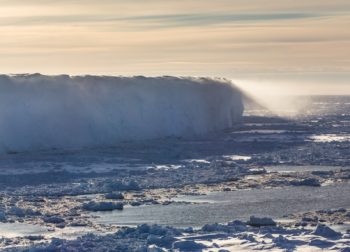
These ice sheet estimates feed directly into projections of sea-level rise resulting from climate change.
They are made by measuring how much material ice sheets are gaining or losing over time, known as mass balance, to assess their long-term health.
Snowfall increases the mass of an ice sheet, while ice melting or breaking off causes it to lose mass, and the overall balance between these is crucial.
Although scientists now have a much better understanding of the melting behavior of ice sheets than they did in previous decades, there are still significant uncertainties about their future melt rates, researchers found.
The new study, published in the scientific journal Earth-Science Reviews, shows that despite recent advances in computer modeling of ice sheets in response to climate change, there are still key deficiencies in the models used to estimate the long-term health of ice sheets and related global sea-level predictions.
Improving these estimates could prove vital to informing the scale of response needed to mitigate the potential impacts of climate change.
Edward Hanna, Professor of Climate Science and Meteorology at the University of Lincoln, UK, co-ordinated the research in co-operation with a leading international group of glaciologists.
Professor Hanna said:
“The ice sheets are highly sensitive indicators of climate change, but despite significant recent improvements in data and knowledge, we still don’t understand enough about how rapidly they are likely to lose mass during and beyond the current century.
“Enhanced observations of ice sheets, mainly from satellite data fed into improved computer simulations, are vital [in helping] refine predictions of future sea-level rise that will result from continued global warming. They are urgently needed to assist climate adaptation and impact planning across the world.”
In the last decade, the Antarctic and Greenland ice sheets have overtaken thousands of smaller glaciers as the major contributors to rising sea levels—it is thought that combined, the sheets contain enough ice to raise global sea levels by as much as 65 meters.
However, while some estimates project a contribution of as much as one and a half meters from Antarctica to global sea-level rise by 2100, others suggest only a few tens of centimeters contribution.
The researchers say there is a pressing need for further research that involves enhanced satellite and ground-based observations, together with more sophisticated, interactive computer models that combine ice masses, the atmosphere, ocean, and solid Earth systems.
Their study involved analysis of recent estimates of the ice sheet and glacier mass balance, as well as highlighting recent advances and limitations in computer-model simulations of ice sheet change as an important basis for future work.
The World Climate Research Programme, the Scientific Committee on Antarctic Research and the International Arctic Science Committee part-sponsored the research.
Read more at Phys.org

















You know, you’re not supposed to be enforcing this greenhouse effect-climate change-melting ice caps-sea level rise BS!